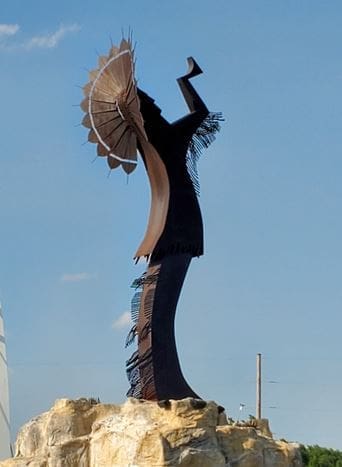By Ron Wilson, director of the Huck Boyd National Institute for Rural Development at Kansas State University
Manhattan, KS- At the confluence of the Big and Little Arkansas Rivers in downtown Wichita stands a magnificent sculpture honoring the native American history of Kansas. This iconic sculpture is known as the Keeper of the Plains. It was created by a Wichita artist of Comanche and Kiowa descent, who had a remarkable career in the arts.
Blackbear Bosin is the artist who created this remarkable work. Much of the following information comes from the book Blackbear Bosin: Keeper of the Indian Spirit, by Bosin’s stepson, David Simmonds.
Blackbear Bosin was born in Oklahoma in 1921 to a Kiowa father and Comanche mother. His native name, which belonged to his paternal grandfather (a Kiowa chief), means Blackbear in English.
Young Blackbear Bosin attended a mission school in Oklahoma where he studied the collection of Kiowa and European art objects and dabbled in painting. He went on to the Chilocco Indian Agricultural School where he trained to work with sheet metal and then moved to Wichita with his wife. During World War II, he enlisted in the Marines.
In 1943, he fell ill and was hospitalized at the naval hospital in Hawaii. There, he took up painting again. His art was so well regarded that the hospital hosted a one-man exhibition of his works before his discharge in 1945.
Having regained his health, he returned to Wichita where he became an industrial designer and product illustrator for Boeing. He later worked in the training aids and arts department at McConnell Air Force Base. Meanwhile, he was building his career as an artist.
In 1946, he entered a painting, called Green Corn Dance, in the Philbrook Art Institute’s first Indian Artists Annual competition and earned his first award.
From 1947-50, his work was on exhibit at the Dallas Museum of Fine Arts, Detroit Institute of Arts, Smithsonian Institution and more. In 1953, he produced Prairie Fire, which would win first place from the Philbrook and was featured in the May 1955 National Geographic. This painting was said to bring him international recognition.
In 1959, Bosin opened the Great Plains Studio in Wichita. In 1960, he won the Grand Prize at the All-Indian Show in New York. The following year he travelled to Switzerland to receive honors after he was elected a Fellow of the International Institution of Arts and Letters.
Bosin was the only Native American artist to participate in the 1965 White House Festival of the Arts. After winning the Victory Trophy from the Philbrook in 1967, he chose to stop entering art competitions because he felt it was time for younger artists to gain recognition.
His creative work continued. He designed the logos for the Mid-America Indian Center in Wichita and the Wolf Creek nuclear power plant which is located near the rural community of Burlington, population 2,764 people. Now, that’s rural.
In 1969, one of Bosin’s friends at the Kansas Gas & Electric Company asked if he would design a large-scale statue as tribute to the Indigenous peoples in the Wichita area. Bosin agreed. It became the iconic structure known as Keeper of the Plains, placed near the rivers in downtown Wichita.
A City of Wichita website describes it as a sculpture “with hands raised in supplication to the Great Spirit.” After a restoration and river beautification project, the five-ton, 44 foot tall sculpture now stands elevated on a 30-foot rock promontory, surrounded by a plaza which describes the Plains Indian way of life.
Bosin was commissioned to create ten designs for the Franklin Mint for a series of sterling silver medals about Native American history. The coins depicted various historical events with one side of the coin featuring the “traditional view” and the other side of the coin featuring the “Indian interpretation” of those events. In 1977, the state of Kansas awarded Bosin the Distinguished Service Award.
Blackbear Bosin passed away in 1980, but his magnificent sculpture still stands on what is considered sacred ground in Wichita. We commend this Kansan for making a difference with creativity in art. Like the Keeper of the Plains statue itself, the impact of Blackbear Bosin stands tall.
Audio and text files of Kansas Profiles are available at http://www.kansasprofile.com. For more information about the Huck Boyd Institute, interested persons can visit http://www.huckboydinstitute.org.













